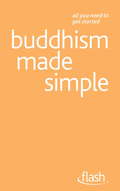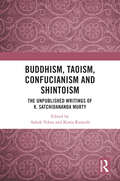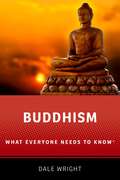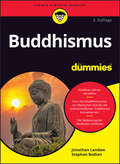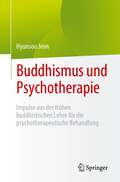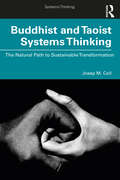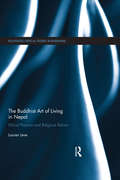- Table View
- List View
Buddhism Made Simple: Buddhism Made Simple (Flash)
by Clive ErrickerThe books in this bite-sized new series contain no complicated techniques or tricky materials, making them ideal for the busy, the time-pressured or the merely curious. Buddhism Made Simple is a short, simple and to-the-point guide to Buddhism. In just 96 pages, the reader will learn all about the history, beliefs and traditions of this major world faith. Ideal for the busy, the time-pressured or the merely curious, Buddhism Made Simple is a quick, no-effort way to break into this fascinating topic.
Buddhism, Modernity, and the State in Asia: Forms of Engagement
by John Whalen-Bridge Pattana KitiarsaLeading scholars working on Buddhism and politics in South and Southeast Asia add to current discussions regarding 'Engaged Buddhism' and the recent work on protests. The writers have mostly established themselves in their fields, offering a diverse approach and country-by-country coverage.
Buddhism Plain and Simple: The Practice Of Being Aware, Right Now, Every Day (Arkana Ser.)
by Steve HagenThis is a book about awareness - it's about being 'awake' and in touch with what is going on here and now. Practical and down-to-earth, it deals exclusively with the present, not with speculation, theory or belief in some far-off time and place. The teachings of the Buddha are plain and straightforward, and because they remain focused on the moment they are just as relevant now as they have ever been. BUDDHISM PLAIN AND SIMPLE is the book for anyone wanting to discover, or rediscover, the essence of Buddhism.
Buddhism, Taoism, Confucianism and Shintoism: The Unpublished Writings of K. Satchidananda Murty
by Ashok Vohra and Kotta RameshK. Satchidananda Murty (1924-2011) was a vociferous writer and an iconoclast. This volume is a collection of his unpublished writings in philosophy. It features Murty's essays on Buddhism, Taoism, Confucianism and Shintoism. The texts study the origins of Indian, Chinese, and Japanese philosophical traditions and provide a comparative study of the different schools of thought. Murty analyses the development of science in the ancient Indian tradition, especially in the areas of geometry, algebra, architecture, engineering, and astronomy. He also provides recommendations for promoting Asian philosophies and cultures to the world, without dependence on the West. An important contribution, the book presents K. Satchidananda Murty's contribution to philosophy during sixty-one years of his engagement with active writing and teaching. It will be of great interest to scholars, teachers, and students of Indian philosophy, Hindu philosophy, comparative philosophy, Asian Philosophy, religious studies, and South Asian studies.
Buddhism, Taoism, Confucianism and Shintoism: The Unpublished Writings of K. Satchidananda Murty
K. Satchidananda Murty (1924-2011) was a vociferous writer and an iconoclast. This volume is a collection of his unpublished writings in philosophy. It features Murty's essays on Buddhism, Taoism, Confucianism and Shintoism. The texts study the origins of Indian, Chinese, and Japanese philosophical traditions and provide a comparative study of the different schools of thought. Murty analyses the development of science in the ancient Indian tradition, especially in the areas of geometry, algebra, architecture, engineering, and astronomy. He also provides recommendations for promoting Asian philosophies and cultures to the world, without dependence on the West. An important contribution, the book presents K. Satchidananda Murty's contribution to philosophy during sixty-one years of his engagement with active writing and teaching. It will be of great interest to scholars, teachers, and students of Indian philosophy, Hindu philosophy, comparative philosophy, Asian Philosophy, religious studies, and South Asian studies.
Buddhism, the Internet, and Digital Media: The Pixel in the Lotus (Routledge Studies in Religion and Digital Culture)
by Gregory Price Grieve Daniel VeidlingerBuddhism, the Internet and Digital Media: The Pixel in the Lotus explores Buddhist practice and teachings in an increasingly networked and digital era. Contributors consider the ways Buddhism plays a role and is present in digital media through a variety of methods including concrete case studies, ethnographic research, and content analysis, as well as interviews with practitioners and cyber-communities. In addition to considering Buddhism in the context of technologies such as virtual worlds, social media, and mobile devices, authors ask how the Internet affects identity, authority and community, and what effect this might have on the development, proliferation, and perception of Buddhism in an online environment. Together, these essays make the case that studying contemporary online Buddhist practice can provide valuable insights into the shifting role religion plays in our constantly changing, mediated, hurried, and uncertain culture.
Buddhism, the Internet, and Digital Media: The Pixel in the Lotus (Routledge Studies in Religion and Digital Culture)
by Gregory Price Grieve Daniel VeidlingerBuddhism, the Internet and Digital Media: The Pixel in the Lotus explores Buddhist practice and teachings in an increasingly networked and digital era. Contributors consider the ways Buddhism plays a role and is present in digital media through a variety of methods including concrete case studies, ethnographic research, and content analysis, as well as interviews with practitioners and cyber-communities. In addition to considering Buddhism in the context of technologies such as virtual worlds, social media, and mobile devices, authors ask how the Internet affects identity, authority and community, and what effect this might have on the development, proliferation, and perception of Buddhism in an online environment. Together, these essays make the case that studying contemporary online Buddhist practice can provide valuable insights into the shifting role religion plays in our constantly changing, mediated, hurried, and uncertain culture.
Buddhism under Capitalism
by Richard K. Payne and Fabio RambelliThis book argues that Buddhism has spread due to globalized capitalism, and explores how capitalism is also impacting Buddhists and Buddhism today. Edited by two leading scholars in Buddhist studies, the book examines how capitalism and neo-liberalism have shaped global perceptions of Buddhism, as well as specific local practices and attitudes. It examines the institutional practices that sustained the spread of Buddhism for two and a half millennia, and the adaptation of Buddhist institutions in contemporary, global economic systems-particularly in Europe and the United States over the last century and half. These innovative essays on the interfaces between Buddhism and capitalism will prompt readers to rethink the connection between Buddhism and secular society. Case studies include digital capitalism, tourism, and monasticism, and are drawn from the USA, Tibet, China, Japan, and Thailand.
Buddhism under Capitalism
This book argues that Buddhism has spread due to globalized capitalism, and explores how capitalism is also impacting Buddhists and Buddhism today. Edited by two leading scholars in Buddhist studies, the book examines how capitalism and neo-liberalism have shaped global perceptions of Buddhism, as well as specific local practices and attitudes. It examines the institutional practices that sustained the spread of Buddhism for two and a half millennia, and the adaptation of Buddhist institutions in contemporary, global economic systems-particularly in Europe and the United States over the last century and half. These innovative essays on the interfaces between Buddhism and capitalism will prompt readers to rethink the connection between Buddhism and secular society. Case studies include digital capitalism, tourism, and monasticism, and are drawn from the USA, Tibet, China, Japan, and Thailand.
Buddhism, Virtue and Environment (Ashgate World Philosophies Series)
by David E. Cooper Simon P. JamesBuddhism, one increasingly hears, is an 'eco-friendly' religion. It is often said that this is because it promotes an 'ecological' view of things, one stressing the essential unity of human beings and the natural world. Buddhism, Virtue and Environment presents a different view. While agreeing that Buddhism is, in many important respects, in tune with environmental concerns, Cooper and James argue that what makes it 'green' is its view of human life. The true connection between the religion and environmental thought is to be found in Buddhist accounts of the virtues - those traits, such as compassion, equanimity and humility, that characterise the life of a spiritually enlightened individual. Central chapters of this book examine these virtues and their implications for environmental attitudes and practice. Buddhism, Virtue and Environment will be of interest not only to students and teachers of Buddhism and environmental ethics, but to those more generally engaged with moral philosophy. Written in a clear and accessible style, this book presents an original conception of Buddhist environmental thought. The authors also contribute to the wider debate on the place of ethics in Buddhist teachings and practices, and to debates within 'virtue ethics' on the relations between human well-being and environmental concern.
Buddhism, Virtue and Environment (Ashgate World Philosophies Series)
by David E. Cooper Simon P. JamesBuddhism, one increasingly hears, is an 'eco-friendly' religion. It is often said that this is because it promotes an 'ecological' view of things, one stressing the essential unity of human beings and the natural world. Buddhism, Virtue and Environment presents a different view. While agreeing that Buddhism is, in many important respects, in tune with environmental concerns, Cooper and James argue that what makes it 'green' is its view of human life. The true connection between the religion and environmental thought is to be found in Buddhist accounts of the virtues - those traits, such as compassion, equanimity and humility, that characterise the life of a spiritually enlightened individual. Central chapters of this book examine these virtues and their implications for environmental attitudes and practice. Buddhism, Virtue and Environment will be of interest not only to students and teachers of Buddhism and environmental ethics, but to those more generally engaged with moral philosophy. Written in a clear and accessible style, this book presents an original conception of Buddhist environmental thought. The authors also contribute to the wider debate on the place of ethics in Buddhist teachings and practices, and to debates within 'virtue ethics' on the relations between human well-being and environmental concern.
BUDDHISM WENK C: What Everyone Needs to Know® (What Everyone Needs to Know)
by Dale S. WrightBuddhism is one of the oldest and largest of the world's religions. But it is also a tradition that has proven to have enormous contemporary relevance. Founded by Siddhartha Gautama, who came to be called the Buddha, the religion has spread from its origins in northeast India, across Asia, and eventually to the West, taking on new forms at each step of the way. Buddhism: What Everyone Needs to Know offers readers a brief, authoritative guide to one of the world's most diverse religious traditions in a reader-friendly question-and-answer format. Dale Wright covers the origins and early history of Buddhism, the diversity of types of Buddhism throughout history, and the status of contemporary Buddhism. This is a go-to book for anyone seeking a basic understanding of the origins, history, teachings, and practices of Buddhism.
Buddhismus für Dummies (Für Dummies)
by Jonathan Landaw Stephan BodianDas Glück liegt in Ihnen, nicht in diesem Buch Erfahren Sie, was den Buddhismus für viele so faszinierend macht. Jonathan Landaw und Stephan Bodian führen leicht verständlich in diese fernöstliche Lehre ein. Sie berichten vom Leben des historischen Buddha und von den unterschiedlichen Traditionen, die sich über die Jahrhunderte entwickelt haben. Die Leser lernen, was es mit dem Kleinen (Hinayana) und dem Großen Fahrzeug (Mahayana) auf sich hat, wie sich der Zen-Buddhismus von der tibetanischen Schule unterscheidet und vieles mehr. Außerdem zeigen die Autoren, wie der Buddhismus unseren Alltag bereichert. Sie erfahren Wie Sie in westlichen Kulturen dem Pfad der Erleuchtung folgen Wie der Geist Glück und Leiden erzeugt Was zum Wesen eines Buddhisten gehört Welche Interpretationen der Erleuchtung es gibt
Buddhismus für Dummies (Für Dummies)
by Jonathan Landaw Stephan Bodian Reinhard EngelDer Dalai Lama ist Kult und in der Nähe von Bordeaux scharen sich die Anhänger um Tich Nhat Hanh. Was macht den Buddhismus für viele so faszinierend? Jonathan Landaw und Stephan Bodian führen leicht verständlich in diese fernöstliche Lehre ein. Sie berichten vom Leben des historischen Buddha und von den unterschiedlichen Traditionen, die sich über die Jahrhunderte entwickelt haben. Die Leser erfahren, was es mit dem Kleinen (Hinayana) und dem Großen Fahrzeug (Mahayana) auf sich hat, wie sich der Zen-Buddhismus von der tibetanischen Schule unterscheidet und wie sich diese Lehre friedlich über ganz Asien verbreitet hat. Doch wer ein achtsames Leben im Sinne des Buddha führen möchte, muss nicht in Indien, Tibet, Thailand oder Burma leben. Die Autoren zeigen, wie der Buddhismus unseren Alltag bereichern kann und dass es auch in westlichen Kulturen möglich ist, dem Pfad der Erleuchtung zu folgen.
Buddhismus und Psychotherapie: Impulse aus der frühen buddhistischen Lehre für die psychotherapeutische Behandlung
by Hyunsoo JeonDieses Buch untersucht, wie man den Buddhismus in der Psychotherapie einsetzen kann und wie der Buddhismus selbst als eine Form der Psychotherapie fungieren kann. Letzteres ist möglich, wenn die die buddhistischen Praktiken als Objektiv für universelle Wahrheit und Weisheit und nicht als Aspekte einer Religion verwendet werden. Basierend auf seinem über 30-jährigen Studiums und Praxis des frühen Buddhismus sowie seinen Erfahrungen mit dem Buddhismus bei seinen Patienten umreißt der Autor eine neue Form der Psychotherapie, die drei buddhistische Prinzipien einbezieht: die Eigenschaften von Körper und Geist, das Prinzip der Bewegung der Welt und das Leben mit Weisheit. Diese Technik bietet eine neue Perspektive auf die psychische Gesundheit und eröffnet Kliniker*innen und Forscher*innen neue Ansätze für einen wirksamen Umgang mit psychischer Gesundheit und Wohlbefinden. Der Autor Dr. Hyusoo Jeon ist Facharzt für Psychiatrie und Psychotherapie in Korea. In seiner Zeit als Assistenzart in der Neuropsychiatrie lernte er die buddhistischen Lehren kennen. Er studierte den Buddhismus, um die buddhistische Weisheit bei der Behandlung seiner Patienten zu nutzen und verfasste mehrere Bücher zu diesem Thema. 2007 gründete er die Koreanische Vereinigung für Buddhismus und Psychotherapie mit und erhielt 2018 den Prize of Wonhyo Scholar Prize des Korean Buddhist Promotion Institute für seinen Beitrag zur nützlichen Anwendung des Buddhismus in der modernen Gesellschaft wurde. Die Übersetzung Dieses Buch stellt die Übersetzung einer englischsprachigen Originalausgabe dar. Die Übersetzung wurde mit Hilfe von künstlicher Intelligenz erstellt (maschinelle Übersetzung mit DeepL.com). Eine anschließende manuelle Überarbeitung erfolgte vor allem nach inhaltlichen Gesichtspunkten, so dass das Buch stilistisch von einer herkömmlichen Übersetzung abweicht.
Buddhist and Christian Responses to the Kowtow Problem in China
by Eric ReindersThe most common Buddhist practice in Asia is bowing, yet Buddhist and Christian Responses to the Kowtow Problem is the first study of Buddhist obeisance in China. In Confucian ritual, everyone is supposed to kowtow, or bow, to the Chinese emperor. But Buddhists claimed exemption from bowing to any layperson, even to their own parents or the emperor. This tension erupted in an imperial debate in 662.This study first asks how and why Buddhists should bow (to the Buddha, and to monks), and then explores the arguments over their refusing to bow to the emperor. These arguments take us into the core ideas of Buddhism and imperial power: How can one achieve nirvana by bowing? What is a Buddha image? Who is it that bows? Is there any ritual that can exempt a subject of the emperor? What are the limits of the state's power over human bodies? Centuries later, Christians had a new set of problems with bowing in China, to the emperor and to "idols.†? Buddhist and Christian Responses to the Kowtow problem compares these cases of refusing to bow, discusses modern theories of obeisance, and finally moves to examine some contemporary analogies such as refusing to salute the American flag. Contributing greatly to the study of the body and power, ritual, religion and material culture, this volume is of interest to scholars and students of religious studies, Buddhism, Chinese history and material culture.
Buddhist and Christian Responses to the Kowtow Problem in China
by Eric ReindersThe most common Buddhist practice in Asia is bowing, yet Buddhist and Christian Responses to the Kowtow Problem is the first study of Buddhist obeisance in China. In Confucian ritual, everyone is supposed to kowtow, or bow, to the Chinese emperor. But Buddhists claimed exemption from bowing to any layperson, even to their own parents or the emperor. This tension erupted in an imperial debate in 662.This study first asks how and why Buddhists should bow (to the Buddha, and to monks), and then explores the arguments over their refusing to bow to the emperor. These arguments take us into the core ideas of Buddhism and imperial power: How can one achieve nirvana by bowing? What is a Buddha image? Who is it that bows? Is there any ritual that can exempt a subject of the emperor? What are the limits of the state's power over human bodies? Centuries later, Christians had a new set of problems with bowing in China, to the emperor and to “idols.” Buddhist and Christian Responses to the Kowtow problem compares these cases of refusing to bow, discusses modern theories of obeisance, and finally moves to examine some contemporary analogies such as refusing to salute the American flag. Contributing greatly to the study of the body and power, ritual, religion and material culture, this volume is of interest to scholars and students of religious studies, Buddhism, Chinese history and material culture.
Buddhist and Taoist Systems Thinking: The Natural Path to Sustainable Transformation (Systems Thinking)
by Josep M. CollBuddhist and Taoist Systems Thinking explores a radical new conception of business and management. It is grounded on the reconnection of humans with nature as the new competitive advantage for living organizations and entrepreneurs that aspire to regenerate the economy and drive a positive impact on the planet, in the context of the Anthropocene. Organizations today struggle in finding a balance between maximizing profits and generating value for their stakeholders, the environment and the society at large. This happens in a paradigm shift characterized by unprecedented levels of exponential change and the emergence of disruptive technologies. Adaptability, thus, is becoming the new business imperative. How can, then, entrepreneurs and organizations constantly adapt and, at the same time, design the sustainable futures they’d like? This book uniquely explores the benefits of applying Buddhist and Taoist Systems Thinking to sustainable management. Grounded in Taoist and Zen Buddhist philosophies, it offers a modern scientific perspective fundamentally based on the concepts of bio-logical adaptability and lifefulness amidst complexity and constant change. The book introduces the new concept of the Gaia organization as a living organism that consciously helps perpetuate the conditions for life on the planet. It is subject to the natural laws of transformation and the principles of oneness, emptiness, impermanence, balance, self-regulation and harmonization. Readers will find applied Eastern systems theories such as the Yin-Yang and the Five Elements operationalized through practical methodologies and tools such as T-Qualia and the Zen Business model. They are aimed at guiding Gaia organizations and entrepreneurs in leading sustainable transformations and qualifying economic growth. The book offers a vital toolkit for purpose-driven practitioners, management researchers, students, social entrepreneurs, evaluators and change-makers to reinvent, create and mindfully manage sustainable and agile organizations that drive systemic transformation.
Buddhist and Taoist Systems Thinking: The Natural Path to Sustainable Transformation (Systems Thinking)
by Josep M. CollBuddhist and Taoist Systems Thinking explores a radical new conception of business and management. It is grounded on the reconnection of humans with nature as the new competitive advantage for living organizations and entrepreneurs that aspire to regenerate the economy and drive a positive impact on the planet, in the context of the Anthropocene. Organizations today struggle in finding a balance between maximizing profits and generating value for their stakeholders, the environment and the society at large. This happens in a paradigm shift characterized by unprecedented levels of exponential change and the emergence of disruptive technologies. Adaptability, thus, is becoming the new business imperative. How can, then, entrepreneurs and organizations constantly adapt and, at the same time, design the sustainable futures they’d like? This book uniquely explores the benefits of applying Buddhist and Taoist Systems Thinking to sustainable management. Grounded in Taoist and Zen Buddhist philosophies, it offers a modern scientific perspective fundamentally based on the concepts of bio-logical adaptability and lifefulness amidst complexity and constant change. The book introduces the new concept of the Gaia organization as a living organism that consciously helps perpetuate the conditions for life on the planet. It is subject to the natural laws of transformation and the principles of oneness, emptiness, impermanence, balance, self-regulation and harmonization. Readers will find applied Eastern systems theories such as the Yin-Yang and the Five Elements operationalized through practical methodologies and tools such as T-Qualia and the Zen Business model. They are aimed at guiding Gaia organizations and entrepreneurs in leading sustainable transformations and qualifying economic growth. The book offers a vital toolkit for purpose-driven practitioners, management researchers, students, social entrepreneurs, evaluators and change-makers to reinvent, create and mindfully manage sustainable and agile organizations that drive systemic transformation.
The Buddhist Art of Living in Nepal: Ethical Practice and Religious Reform (Routledge Critical Studies in Buddhism)
by Lauren LeveTheravada Buddhism has experienced a powerful and far-reaching revival in modern Nepal, especially among the Newar Buddhist laity, many of whom are reorganizing their lives according to its precepts, practices and ideals. This book documents these far-reaching social and personal transformations and links them to political, economic and cultural shifts associated with late modernity, and especially neoliberal globalization. Nepal has changed radically over the last century, particularly since the introduction of liberal democracy and an open-market economy in 1990. The rise of lay vipassana meditation has also dramatically impacted the Buddhist landscape. Drawing on recently revived understandings of ethics as embodied practices of self-formation, the author argues that the Theravada turn is best understood as an ethical movement that offers practitioners ways of engaging, and models for living in, a rapidly changing world. The book takes readers into the Buddhist reform from the perspectives of its diverse practitioners, detailing devotees' ritual and meditative practices, their often conflicted relations to Vajrayana Buddhism and Newar civil society, their struggles over identity in a formerly Hindu nation-state, and the political, cultural, institutional and moral reorientations that becoming a "pure Buddhist"—as Theravada devotees understand themselves—entails. Based on more than 20 years of anthropological fieldwork, this book is an important contribution to scholarly debates over modern Buddhism, ethical practices, and the anthropology of religion. It is of interest to students and scholars of Asian Religion, Anthropology, Buddhism and Philosophy.
The Buddhist Art of Living in Nepal: Ethical Practice and Religious Reform (Routledge Critical Studies in Buddhism)
by Lauren LeveTheravada Buddhism has experienced a powerful and far-reaching revival in modern Nepal, especially among the Newar Buddhist laity, many of whom are reorganizing their lives according to its precepts, practices and ideals. This book documents these far-reaching social and personal transformations and links them to political, economic and cultural shifts associated with late modernity, and especially neoliberal globalization. Nepal has changed radically over the last century, particularly since the introduction of liberal democracy and an open-market economy in 1990. The rise of lay vipassana meditation has also dramatically impacted the Buddhist landscape. Drawing on recently revived understandings of ethics as embodied practices of self-formation, the author argues that the Theravada turn is best understood as an ethical movement that offers practitioners ways of engaging, and models for living in, a rapidly changing world. The book takes readers into the Buddhist reform from the perspectives of its diverse practitioners, detailing devotees' ritual and meditative practices, their often conflicted relations to Vajrayana Buddhism and Newar civil society, their struggles over identity in a formerly Hindu nation-state, and the political, cultural, institutional and moral reorientations that becoming a "pure Buddhist"—as Theravada devotees understand themselves—entails. Based on more than 20 years of anthropological fieldwork, this book is an important contribution to scholarly debates over modern Buddhism, ethical practices, and the anthropology of religion. It is of interest to students and scholars of Asian Religion, Anthropology, Buddhism and Philosophy.
Buddhist-Christian Dialogue, U.S. Law, and Womanist Theology for Transgender Spiritual Care
by Pamela Ayo YetundeThis book, written with hospital spiritual care providers in mind, investigates how to expand the field and scope of compassion within the hospital context, for the spiritual care and safety of transgender patients. Written by a law-educated pastoral counselor, it advocates for chaplain legal literacy, and explains the consequences of spiritual care providers not knowing more about the law. It explores the current political and legal situation transgender hospital patients find themselves in, and especially how these new policies put transgender people at risk when they are in a hospital setting. Pamela Ayo Yetunde offers Buddhist-Christian activist interreligious dialogue methods to promote deeper understanding of how spiritual practices can cultivate empathy for transgender patients.
Buddhist-Christian Dual Belonging: Affirmations, Objections, Explorations
by Gavin D'Costa Ross ThompsonA growing number of people describe themselves as both Buddhist and Christian; but does such a self-description really make sense? Many people involved in inter-faith dialogue argue that this dialogue leads to a mutually transformative process, but what if the transformation reaches the point where the Buddhist or Christian becomes a Buddhist Christian? Does this represent a fulfilment of or the undermining of dialogue? Exploring the growing phenomenon of Buddhist-Christian dual belonging, a wide variety of authors including advocates, sympathisers and opponents from both faiths, focus on three key questions: Can Christian and Buddhist accounts and practices of salvation or liberation be reconciled? Are Christian theism and Buddhist non-theism compatible? And does dual belonging inevitably distort the essence of these faiths, or merely change its cultural expression? Clarifying different ways of justifying dual belonging, contributors offer criticisms of dual belonging from different religious perspectives (Theravada Buddhist, Evangelical Reformed and Roman Catholic) and from different methodological approaches. Four chapters then carry the discussion forward suggesting ways in which dual belonging might make sense from Catholic, Theravada Buddhist, Pure-land Buddhist and Anglican perspectives. The conclusion clarifies the main challenges emerging for dual belongers, and the implications for interreligious dialogue.
Buddhist-Christian Dual Belonging: Affirmations, Objections, Explorations
by Gavin D’costa Ross ThompsonA growing number of people describe themselves as both Buddhist and Christian; but does such a self-description really make sense? Many people involved in inter-faith dialogue argue that this dialogue leads to a mutually transformative process, but what if the transformation reaches the point where the Buddhist or Christian becomes a Buddhist Christian? Does this represent a fulfilment of or the undermining of dialogue? Exploring the growing phenomenon of Buddhist-Christian dual belonging, a wide variety of authors including advocates, sympathisers and opponents from both faiths, focus on three key questions: Can Christian and Buddhist accounts and practices of salvation or liberation be reconciled? Are Christian theism and Buddhist non-theism compatible? And does dual belonging inevitably distort the essence of these faiths, or merely change its cultural expression? Clarifying different ways of justifying dual belonging, contributors offer criticisms of dual belonging from different religious perspectives (Theravada Buddhist, Evangelical Reformed and Roman Catholic) and from different methodological approaches. Four chapters then carry the discussion forward suggesting ways in which dual belonging might make sense from Catholic, Theravada Buddhist, Pure-land Buddhist and Anglican perspectives. The conclusion clarifies the main challenges emerging for dual belongers, and the implications for interreligious dialogue.
